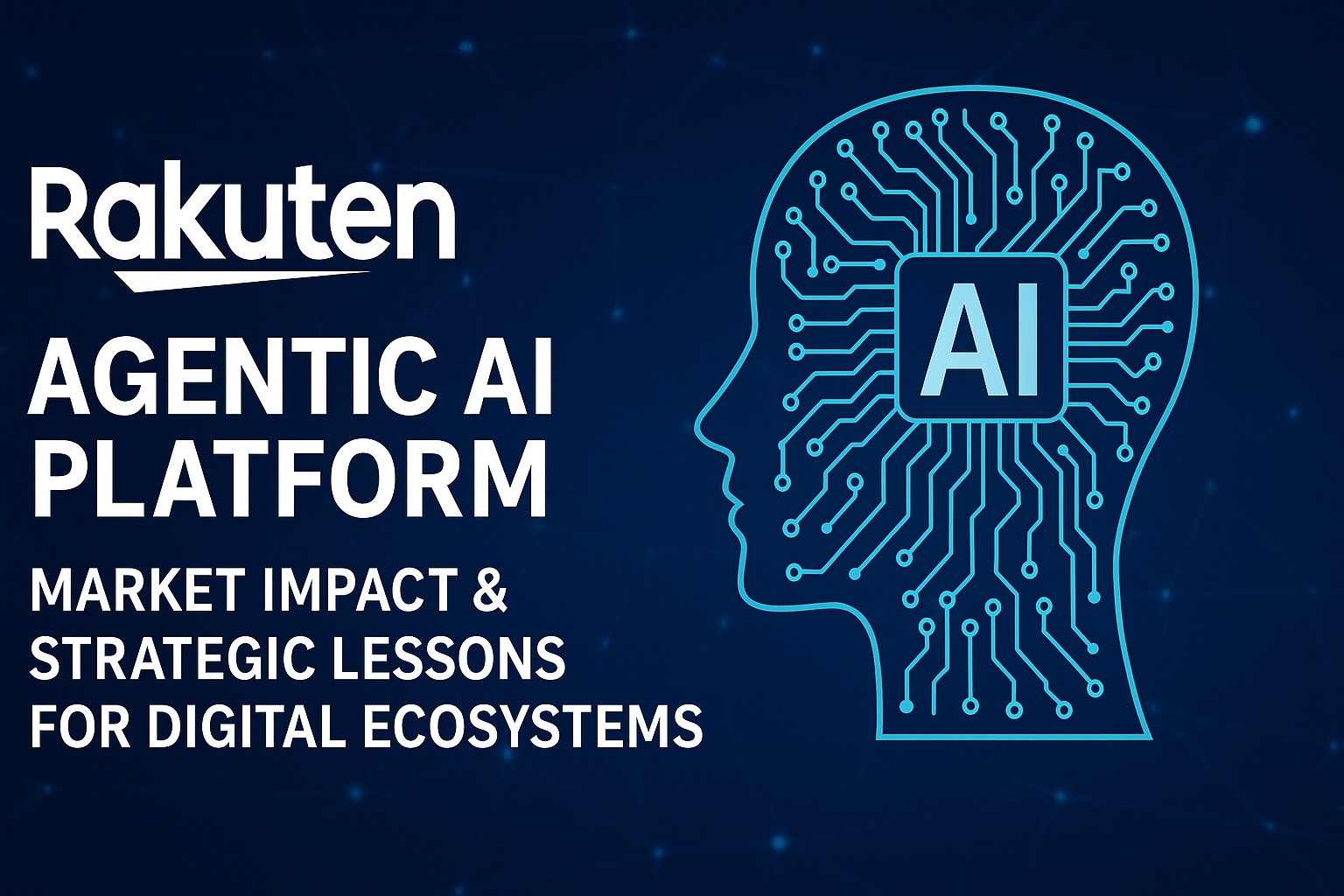A Quick Recap of the Launch
On 30 July 2025 Rakuten Group rolled out “Rakuten AI” on two fronts: inside Rakuten Link (its voice‑and‑messaging app for 9 million mobile subscribers) and as a free, stand‑alone web application. A second wave will embed the agent into Japan’s second‑largest e‑commerce marketplace, Rakuten Ichiba, in autumn 2025Rakuten Group, Inc.corp.mobile.rakuten.co.jp.
Chief AI & Data Officer Ting Cai framed the product as the first gateway to a company‑wide “Agentic Ecosystem,” where task‑orchestrating AI agents sit between the user and every Rakuten serviceRCR Wireless News.
Why This Matters for Japan’s Digital Market
| Impact Area | Near‑Term Effect (2025‑26) | Strategic Implications |
|---|---|---|
| Telecom | Mobile customers gain an AI “concierge” baked into the dialer, a differentiator against NTT Docomo, KDDI and SoftBank. | Telcos must shift from price wars to service stickiness driven by AI‑first apps. |
| E‑commerce | Rakuten Ichiba processed ¥5.96 tn GMS in FY‑2024. Hyper‑personalised agents are expected to lift conversion and basket size in 2026. | Marketplaces without native agents risk lower session time and GMV.Rakuten Group, Inc. |
| FinTech / Cross‑Sell | Mobile users already spend 49.7 % more on Ichiba and 25.9 % more on Rakuten Card versus non‑subscribers; AI is poised to widen these gaps through predictive offers.Rakuten Today | Ecosystem players should treat AI as a monetisation flywheel rather than a cost centre. |
| Generative‑AI Industry | Japan’s generative‑AI market is only US $0.86 bn today but growing 17 % CAGR to 2033. Rakuten’s mass‑consumer launch accelerates demand beyond B2B sandboxes.IMARC Group | Expect faster regulatory scrutiny (see JFTC study) and talent competition.jftc.go.jp |
Competitive Benchmark
- LY Corporation (LINE & Yahoo Japan) – rolled out GPT‑4o‑based LINE AI Assistant for 94 million monthly users and mandated a RAG tool (“SeekAI”) for 11 000 staff. Focus is employee productivity first, consumer secondOpenAIMediumYahoo Finance.
- SoftBank – targets 1 billion internal and external AI agents in 2025, betting on cross‑industry “digital labour.”Light Reading
- Mercari – uses AI mainly for listing optimisation and seller support, not as a universal gateway.OpenAI
Rakuten is the first in Japan to fuse (1) telco reach, (2) a full‑stack commerce/fintech ecosystem and (3) a multimodal, culturally tuned agent under one ID—putting pressure on rivals to close the “orchestration gap.”
Inside Rakuten’s Playbook

- Multimodal UX – Text, voice‑to‑text, image search and AI‑generated follow‑ups lower friction and boost query depthRakuten Group, Inc..
- Cultural Fine‑Tuning – Models are explicitly trained on Japanese linguistic nuance and etiquette, yielding higher relevance than generic chatbotsRCR Wireless News.
- Ecosystem Unification – A single agent surfaces inventory, payment, travel, media and loyalty data—turning silos into compound advantage.
- Employee‑First AI Culture – 30 000 staff already use Rakuten‑internal agents; 8 000 log in daily, halving prep time for sales collateral and emailsRakuten Today.
- Responsible‑AI Guardrails – The group published a public ethics framework and collaborates with regulators to pre‑empt compliance riskRakuten Group, Inc..
Strategic Lessons for Other Enterprises
| Lesson | Why It Matters | First Steps to Adapt |
|---|---|---|
| Build the “agentic layer” first, not last | Orchestrating services via LLM agents unlocks value faster than piecemeal chatbots. | Audit APIs and micro‑services; adopt frameworks such as LangGraph or similar to compose task chains. |
| Local‑language fine‑tuning > model size | Rakuten’s cultural fluency is a key moat. | Invest in domain‑specific datasets and continuous feedback loops with local users. |
| Make AI the default entry point | A unified interface reduces churn and multiplies cross‑sell. | Promote the agent inside existing high‑traffic apps (e.g., banking, telecom, ride‑hailing). |
| Start with employees to de‑risk consumer roll‑out | Internal use drives rapid iteration and ROI proof before public exposure. | Launch an internal “AI studio” with templated agents for docs, coding and customer support. |
| Embed responsible‑AI ops early | Japan’s JFTC and global regulators are watching generative‑AI competition closely. | Establish cross‑functional governance teams; publish principles and red‑teaming results. |
Looking Ahead
If successful, Rakuten will reset Japanese consumers’ expectations: an AI agent that knows you and every service you use. For competitors, the window to replicate an ecosystem‑scale, multimodal, culturally aligned agent is narrow. Those who act now—merging siloed data, prioritising mobile entry points and hard‑wiring responsible‑AI pipelines—can still ride the coming wave rather than be swept aside by it.
Bottom line: Rakuten’s launch is less about another chatbot and more about re‑platforming an entire digital conglomerate around autonomous agents. Enterprises that grasp this shift will future‑proof their user engagement models; those that don’t may find themselves operating on yesterday’s internet.









